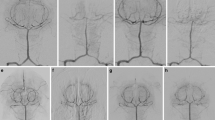Summary
¶ Background. Cerebral vasospasm after subarachnoid hemorrhage (SAH) has remained a major cause of morbidity and mortality in patients with SAH. Excitatory neurotransmitters are gathered in the extracellular space during ischemia due to cerebral vasospasm and initiate or stimulate a series of pathophysiological biochemical processes which consequently lead to neuronal death. Tizanidine (Sandoz compound DS 103–282, 5-chloro-4,2 (2-imidazolin-2-yl-amino)-2,1,3-benzothiazol hydrochloride) is a centrally-acting muscle relaxant and a selective α 2 adrenoreceptor agonist which shows its effect by stimulating presynaptic α 2 adrenoreceptors in central ASPergic and GLUergic system by inhibiting aspartic acid and glutamic acid release. In this study, the effect of Tizanidine on vasospasm was evaluated.
Methods. We used a femoral artery vasospasm model in rats which has been described by Okada et al. 60 rats were examined in three groups. The first group was used as control group (Control) (n=20), in the second group subarachnoid hemorrhage was performed (SAH) (n=20), in the third group Tizanidine was administered in addition to SAH (SAH+Tizanidine administration) (n=20). Animals in SAH+Tizanidine administration group received 0,3 mg/kg/day intraperitoneally for 7 days. Seven days after the experiment, after perfusion-fixation, 10 mm segments of both femoral arteries were removed and the femoral artery was prepared for light microscope examination, scanning and transmission electron microscopy and for morphometric analysis.
Results. There was a statistically significant difference between the electron, scanning and light microscopic observations and morphometric analysis of SAH+Tizanidine administration group and SAH group, and no statistically significant difference between SAH+Tizanidine administration group and control group.
Conclusion. This study has disclosed that Tizanidine administration before the vasospasm reduces ultrastructural and morphometric vasospastic insult significantly. However, the clinical application of Tizanidine as a protective and therapeutic agent in cerebral vasospasm needs further studies including the employment of clinically more relevant SAH models.
Similar content being viewed by others
Author information
Authors and Affiliations
Rights and permissions
About this article
Cite this article
Berkman, M., İplikçioğlu, A., Berkman, M. et al. The Effect of Tizanidine on Chronic Vasospasm in Rats. Acta Neurochir (Wien) 142, 1047–1054 (2000). https://doi.org/10.1007/s007010070061
Issue Date:
DOI: https://doi.org/10.1007/s007010070061




